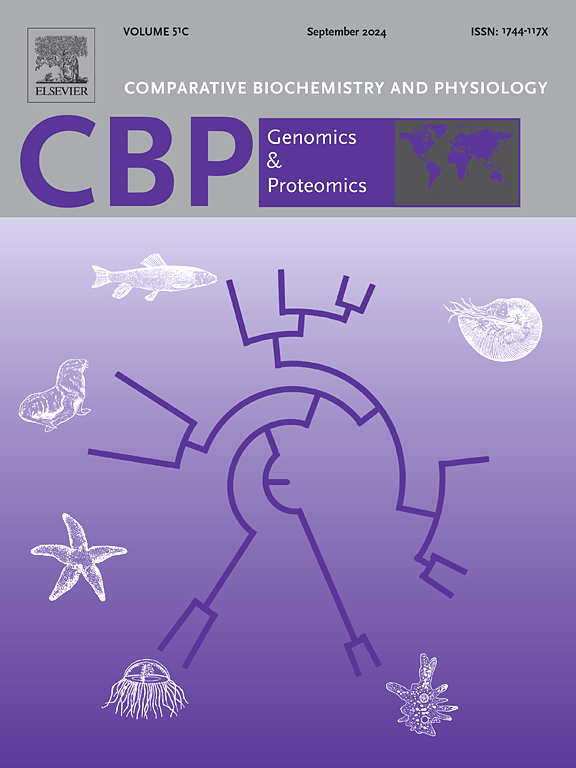Comparative genome analysis and global methylation patterns for epigenetic study in the brackish water flea Diaphanosoma celebensis
IF 2.2
2区 生物学
Q4 BIOCHEMISTRY & MOLECULAR BIOLOGY
Comparative Biochemistry and Physiology D-Genomics & Proteomics
Pub Date : 2025-03-24
DOI:10.1016/j.cbd.2025.101493
引用次数: 0
Abstract
The brackish water flea Diaphanosoma celebensis is a crucial organism in brackish and estuarine ecosystems, acting as a key trophic link between primary producers and higher trophic levels. Its small size, short life cycle, and high reproductive capacity make it an ideal model for studying ecological responses to environmental stressors, especially in polluted environments. This study provides a chromosome-level genome assembly of D. celebensis, consisting of 22 chromosomes with an N50 of 4,113,329 base pairs and 95.1 % completeness, achieved by combining de novo assembly with Hi-C data from D. dubium. Whole-genome bisulfite sequencing (WGBS) revealed distinct DNA methylation patterns, with exons showing higher methylation than introns and intergenic regions. A detailed analysis identified four gene clusters based on methylation levels. Cluster δ (highly methylated), enriched for pathways related to protein processing, ribosomal activity, and ubiquitin-mediated proteolysis, suggests a regulatory mechanism for stress adaptation in D. celebensis. In contrast, cluster α (hypo methylated), associated with transcription regulation and neural functions, highlights genes involved in cellular processes that may respond dynamically to environmental changes. Functional gene comparisons indicated significant differences in pathways related to ion transport and ubiquitination, emphasizing the unique adaptations of D. celebensis to its brackish environment. These findings provide a deeper understanding of the species' genomic and epigenetic regulation, offering valuable insights for future studies on its adaptation to environmental pollutants.

苦咸水蚤表观遗传比较基因组分析及甲基化模式研究
咸淡水蚤是咸淡水和河口生态系统中的重要生物,是初级生产者和高营养水平之间的关键营养纽带。其体积小,生命周期短,繁殖能力强,是研究环境胁迫下生态反应的理想模型,特别是在污染环境中。本研究提供了D. celebensis染色体水平的基因组组装,包括22条染色体,N50为4,113,329个碱基对,完整性为95.1%,通过将de novo组装与D. dubium的Hi-C数据相结合实现。亚硫酸氢盐全基因组测序(WGBS)显示出不同的DNA甲基化模式,外显子的甲基化程度高于内含子和基因间区。一项详细的分析根据甲基化水平确定了四个基因簇。簇δ(高度甲基化),富含与蛋白质加工、核糖体活性和泛素介导的蛋白质水解相关的途径,表明了D. celebensis逆境适应的调节机制。相比之下,簇α(低甲基化)与转录调控和神经功能相关,突出了参与细胞过程的基因,这些基因可能对环境变化做出动态反应。功能基因比较表明,与离子转运和泛素化相关的途径存在显著差异,强调了D. celebensis对其微咸环境的独特适应。这些发现提供了对该物种基因组和表观遗传调控的更深入了解,为未来研究其对环境污染物的适应提供了有价值的见解。
本文章由计算机程序翻译,如有差异,请以英文原文为准。
求助全文
约1分钟内获得全文
求助全文
来源期刊
CiteScore
5.10
自引率
3.30%
发文量
69
审稿时长
33 days
期刊介绍:
Comparative Biochemistry & Physiology (CBP) publishes papers in comparative, environmental and evolutionary physiology.
Part D: Genomics and Proteomics (CBPD), focuses on “omics” approaches to physiology, including comparative and functional genomics, metagenomics, transcriptomics, proteomics, metabolomics, and lipidomics. Most studies employ “omics” and/or system biology to test specific hypotheses about molecular and biochemical mechanisms underlying physiological responses to the environment. We encourage papers that address fundamental questions in comparative physiology and biochemistry rather than studies with a focus that is purely technical, methodological or descriptive in nature.

 求助内容:
求助内容: 应助结果提醒方式:
应助结果提醒方式:


